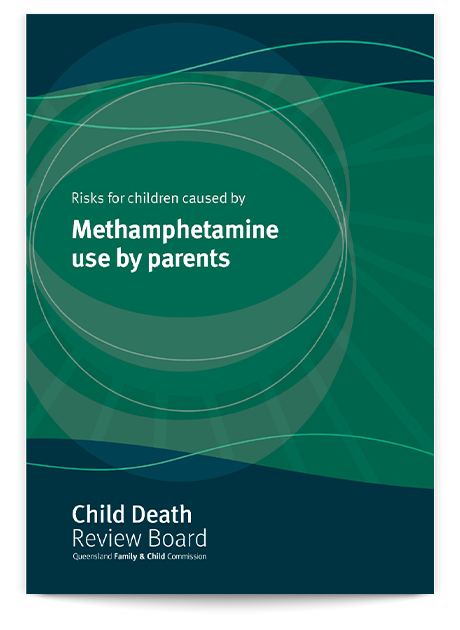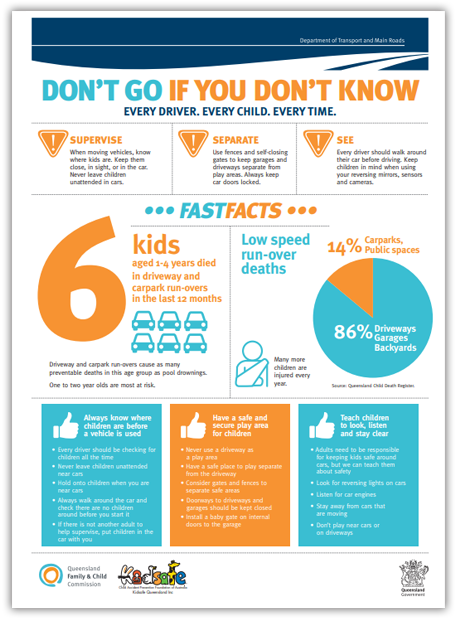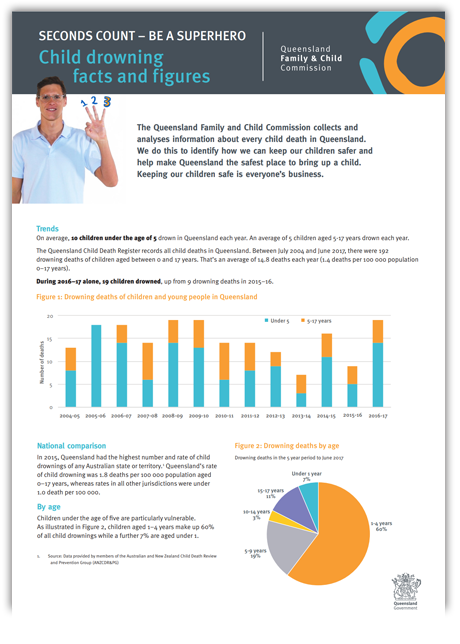- Home
- Sector
- Child Death
- ...
- Preventing child death

Risks for children caused by Methamphetamine use by parents
Given the concerning rate at which parental methamphetamine use was being identified in reviews of deaths of children known to the Queensland child protection system, the Child Death Review Board sought to better understand the impact of parental methamphetamine use on the health and wellbeing of children.
This report contains a particular focus on very young children, under three years of age and identifies potential opportunities for system improvements to respond to and reduce the risk of harm to this vulnerable cohort.

Driveway safety
Most people associate the risk of being run over with speeding and being struck by a stranger who isn’t paying attention. However many of these accidents happen at low speed, in driveways and garages, and involve cars driven by someone the child knows well—often their mum or dad.
Low speed run overs can be fatal, particularly for younger aged children.
It’s important to keep children away from moving vehicles. Always check where children are before you move a car—every car, every child, every time.
We are working closely with the Queensland Department of Transport and Main Roads and Kidsafe Queensland to promote driveway and car park safety.
We’ve jointly produced a factsheet with information about how to help your children play safe away from cars and stay safe when near cars.
Watch the Seconds Count video with swim sensation and Commonwealth Games gold-medallist Mitch Larkin on how to keep kids safe around water.
Did you know that drowning is the leading causes of death for toddlers and young children?
Swimming pools can be fun but it’s also important to know the risks they pose for young children.
There are a number of steps you can take to keep kids safe around water. These include:
- Providing active supervision
- Installing and maintaining a compliant pool fence
- Teaching kids water safety awareness
- Having an emergency action plan
Watch our video How safe is your pool?
What is active supervision?
Active supervision is the key to preventing drowning. Children under 5 must be actively supervised at all times when around water. This means the child is in the direct line of sight of an appropriate adult at all times.
When in the water, kids under 5 must be within arm’s reach of the designated supervisor at all times, regardless of their swimming ability. Young children easily forget what they have learnt in swimming lessons.
If you leave the pool area, always take the child with you. Children under 5 can’t reliably follow an instruction to stay out of the water when not supervised.
Supervision at public pools is your responsibility - lifeguards cannot provide the close and constant supervision young children need.
Also remember, flotation devices are no substitute for active supervision.
Who should be a supervisor?
A child under 5 requires active supervision from a capable adult. Other children are not appropriate supervisors for young children.
Make sure the designated supervisor is aware of their responsibilities. Young children have drowned when adults aren’t clear who is responsible for watching them.
You can't provide active supervision if you are:
- swimming elsewhere in the pool
- chatting with others
- looking at your mobile phone
- affected by alcohol.
What if my child isn't around water?
Kids who aren't around water can get access to a pool and drown before you realise they’re missing. Check on your child regularly even if they are not around water.
Why do I need pool fencing?
All private swimming pools in Queensland must have compliant pool fencing that has been certified by a qualified pool safety inspector. This includes portable pools continually filled with water to a depth of more than 300mm. Your pool must also be registered and have a CPR (cardio-pulmonary resuscitation) sign nearby.
Compliant pool fencing helps prevent children from drowning. Non-compliant pool fencing was present in over three quarters of pool drownings of under 5s in Queensland.
What is compliant fencing?
The Queensland Building and Construction Commission provides information about the requirements for compliant pool fencing and registering your pool.
You can also download the Guidelines for pool owners and property agents from the Department of Housing and Public Works website.
Remember to keep your pool fence and gate in good condition:
- Check the gate’s self-closing and self-latching mechanisms are always working, and that the gate has closed behind you when you leave the pool area.
- Fix fences and/or gates immediately.
- Never leave the gate propped open for any reason, even if you are only gone for a short time.
- Make sure there is nothing nearby that the child could use to climb the fence or open the gate to gain entry to the pool.
Remember that even compliant pool fencing does not guarantee kids are safe. Children are resourceful, and can use objects to help them climb the fence or open the gate. Even shallow wading pools are a drowning hazard - make sure you empty these when not in use.
Young children require active supervision, but teaching them to be safe around water provides another layer of protection. This can include:
- survival swimming skills
- ‘go’ and ‘no go’ zones around the home and yard
- creating a secure, safe play area away from the swimming pool, and removing toys from the pool area so children aren’t tempted to gain access
- educating children about the risks and reinforcing rules about entering the pool area.
More information about swimming skills for young children is available from:
- Kids alive - information and resources for teaching water safety to young children
- Swim and Survive - a water safety initiative of the Royal Life Saving Society Australia
- Austswim - a national organisation for teaching swimming and water safety
It’s important to know what to do if the unexpected happens.
- Have a plan to take kids out of the pool area if you cannot provide active supervision (for example, if you need to answer the phone).
- If a child is missing, always check the pool or other water hazards first. Make sure you search the bottom of the pool and have your phone with you to alert emergency services if needed.
- Teach children when and how they should contact emergency services.
- Learn CPR.
A range of registered training organisations offer CPR courses, including:
Last updated
10 May 2024


